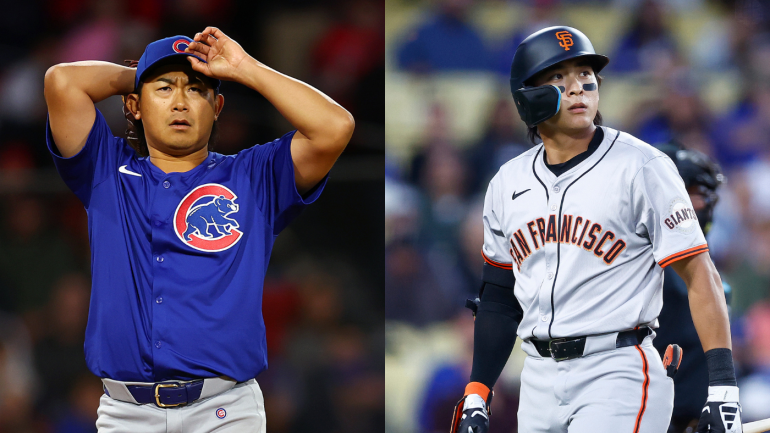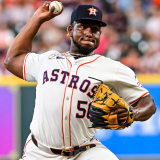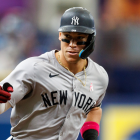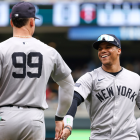
Back in December, we wrote that Major League Baseball's offseason belonged to the international free agent. Every day, headlines seemed to be dominated by players who got their start in either Japan's Nippon Professional Baseball league, or South Korea's Korea Baseball Organization. That group included Shohei Ohtani and Yoshinobu Yamamoto, a tandem that entered the winter atop our free-agent rankings. Our analysis proved correct, with Ohtani and Yamamoto each joining the Los Angeles Dodgers after signing the two most lucrative deals handed out all offseason.
Ohtani has since maintained his brilliance despite enduring an off-the-field scandal that saw his longtime interpreter and friend Ippei Mizuhara allegedly steal more than $16 million to cover illegal gambling debts. Yamamoto, for his part, had a poor introduction to the majors but he's since turned it around. Our Mike Axisa noted earlier today that Yamamoto has recorded a scoreless outing in three of his six starts to date.
But, for as deserving as Ohtani and Yamamoto are of the attention, they aren't the only recent international arrivals having strong seasons. Indeed, Chicago Cubs lefty Shota Imanaga and San Francisco Giants center fielder Jung Hoo Lee both deserve their share of credit for making quick and successful transitions to the majors.
With that in mind, CBS Sports decided to dig in on those two players by revisiting what we wrote last winter and offering new analysis after the season's first month. Scroll slowly with us, won't you?
Shota Imanaga, LHP, Cubs
Season to date: 0.98 ERA (439 ERA+), 9.33 strikeout-to-walk ratio in 27 2/3 innings.
What we wrote last winter: "Imanaga is a fastball-heavy pitcher, slinging his rising low-90s heater close to 60% of the time. He's thrown just one other pitch more than 15% of the time this season: his low-80s slider. Imanaga does have a ton of other pitches that play cameo roles, including a low-70s curve and a low-80s changeup. He does a good job of generating chases with his fastball, while his slider has coerced nearly 40% whiffs."
What we make of him now: Imanaga remains fastball-dependent, chucking his heater around 60% of the time. Predictability hasn't mattered. Opponents are hitting .115 against his fastball with a 21% whiff rate. Credit that success to the optical illusion he creates by marrying a rising fastball with a low release point. Imanaga's fastball averages more than 19 inches of induced vertical break despite a release height around 5.5 feet; for reference, Cristian Javier is the only starting pitcher with more IVB from a sub-6 foot release point, and Imanaga's release point is several inches lower.
Shōta Imanaga, Filthy 84mph Splitter. ✌️
— Rob Friedman (@PitchingNinja) April 27, 2024
7th K...and is fired up! #SuperShota 🔥🦸 pic.twitter.com/5Muwbh31JY
The most interesting development with Imanaga's arsenal is that he's validated a prediction we made elsewhere by upping his splitter's usage. He's already thrown 112 splitters this season across five appearances; last year, he threw fewer than 150 in 24 outings. In turn, the splitter has become his main secondary pitch, with his sweeping slider taking tertiary status. That decision has paid dividends so far: Imanaga's splitter, which features similar horizontal movement as his fastball but without the same vertical rise, has generated an arsenal-high 42.9% whiff rate.
It's worth noting that Imanaga and his stair-stepping ways have yet to face the same opponent twice. Whether or not that makes any difference will have to be determined at a later date. His next two opponents, the New York Mets and the San Diego Padres, will both be first-time encounters.
Jung Hoo Lee, CF, Giants
Season to date: .269/.333/.356 (101 OPS+), 0.4 WAR in 27 games.
What we wrote last winter: "It's to be seen if and how Lee is impacted by the fractured ankle heading forward. Up to this point, he's been regarded as a plus runner and defender. Those attributes are important to his game, since there's always skepticism about how KBO hitters will take to MLB pitching. At minimum, he may require some time to adjust to his new surroundings, making him more dependent on his secondary skills. Lee has displayed above-average contact and zone-management skills throughout his career, having walked more than he's struck out in five consecutive seasons. This year, he whiffed on just 9% of the swings he took overall, including only 3% of the time versus fastballs. Lee does have some juice in his bat, though the home-run ball has seldom been part of his attack (23 of his 65 career home runs came in 2022)."
What we make of him now: As with Imanaga, Lee has mostly stayed true to our old report. Put another way: if you go to his Baseball Savant page, you'll see that he ranks in the 39th percentile in offense, as opposed to the 99th in baserunning and the 73rd in defense.
At the plate, Lee has displayed a patient approach. He's been particularly adept at making contact, running an 89.5% contact rate that ranks third among qualified batters behind Steven Kwan and Luis Arraez. Lee's lack of slugging should come as no surprise: he's shown some strength, topping out with a 108.9 mph exit velocity that puts him in company with the likes of Nick Castellanos and Gleyber Torres, but most of his hardest contact is the ground-ball variety. To wit, of his 24 batted balls that cleared 100 mph, 11 had a launch angle of 5 degrees or lower and only one has topped 20 degrees. (Do note that most home runs range between 20 and 40 degrees.)
정후 날려버려
— SFGiants (@SFGiants) March 31, 2024
Lee's first launch 🚀 pic.twitter.com/JfXP0PN3Pl
Defensively, Lee has leveraged his speed to make every play you would expect him to, as well as a few that you may not have. (This one is arguably the most impressive.) He hasn't had many opportunities to show off his strong arm. Baserunners have only attempted advances 30% of the time, a percentage that ranks 18th (in a good way) out of 122 qualified outfielders, according to data provided by Statcast.
Interestingly enough, Lee has been caught stealing on three of his five attempts, suggesting that he hasn't mastered the art of thievery. Nevertheless, he's salvaged his baserunning metrics by being an asset whenever the ball is put into play. Lee is three-for-three on first-to-third opportunities (not yet drawing a throw), as well as two-for-two on first-to-home attempts. Overall, he's taking the extra base 50% of the time; the league-average mark thus far this season is 42%.
As with Imanaga, it'll be worth monitoring how pitchers adjust to Lee once they've faced him multiple times. For now, though, he appears to be as advertised.






















